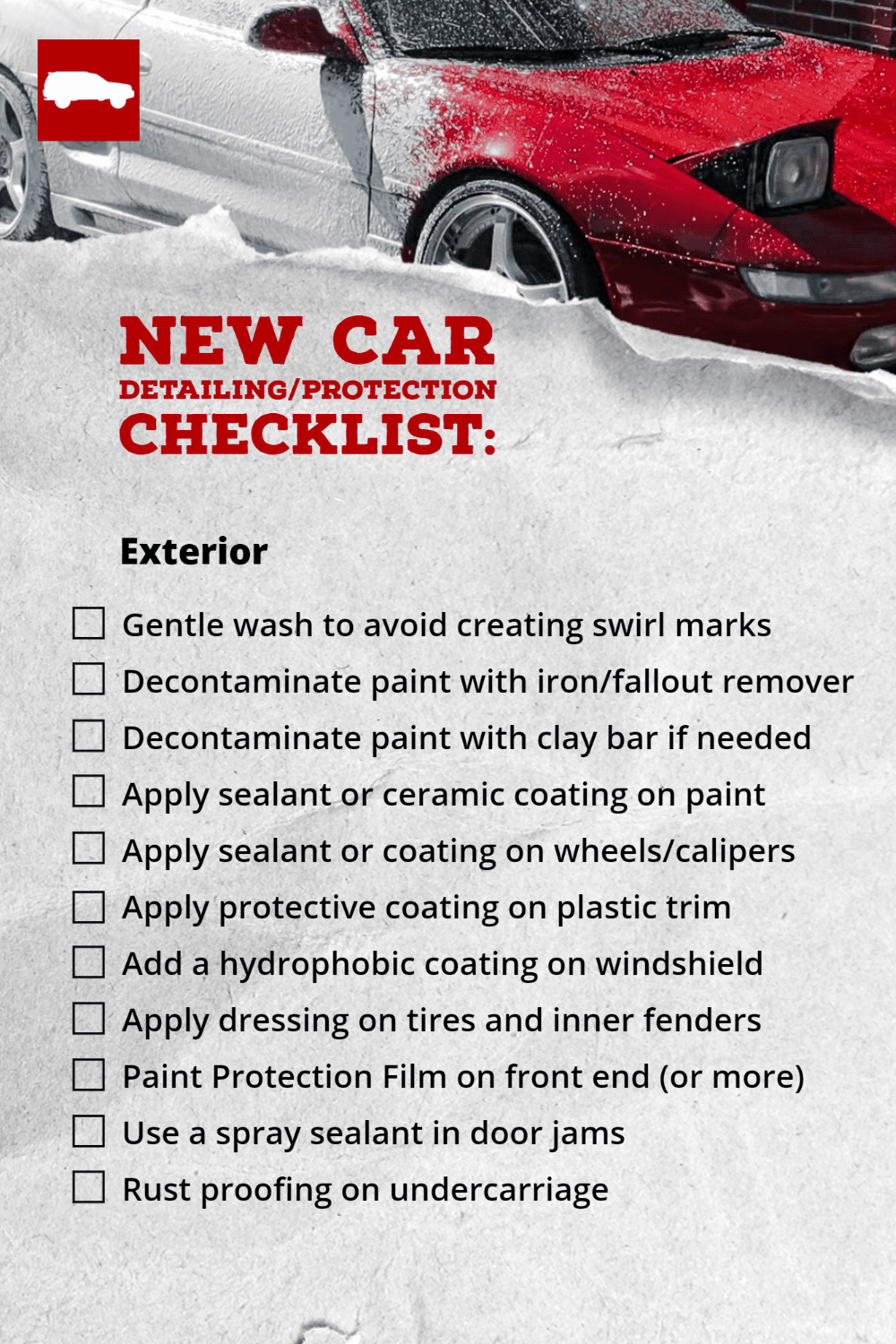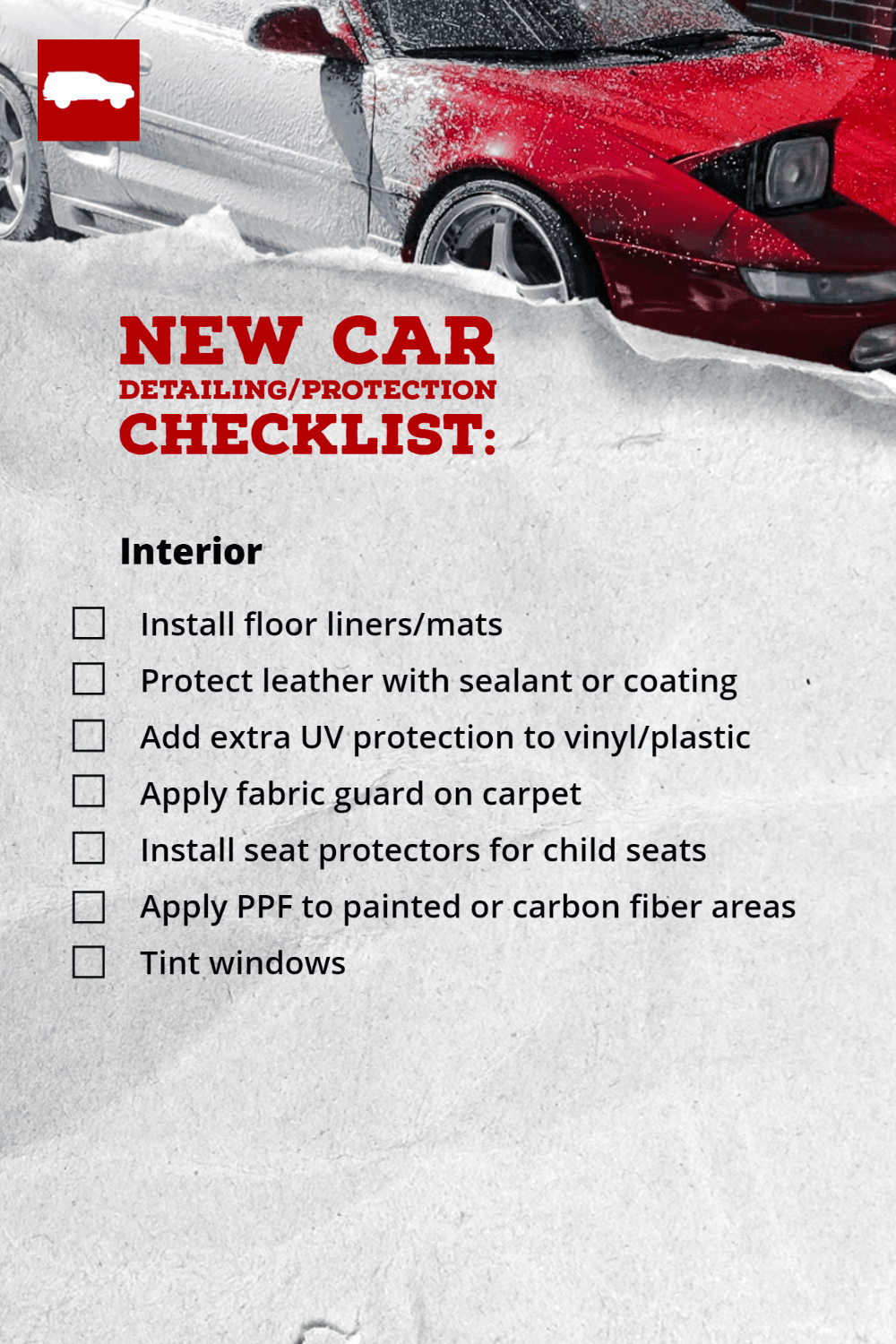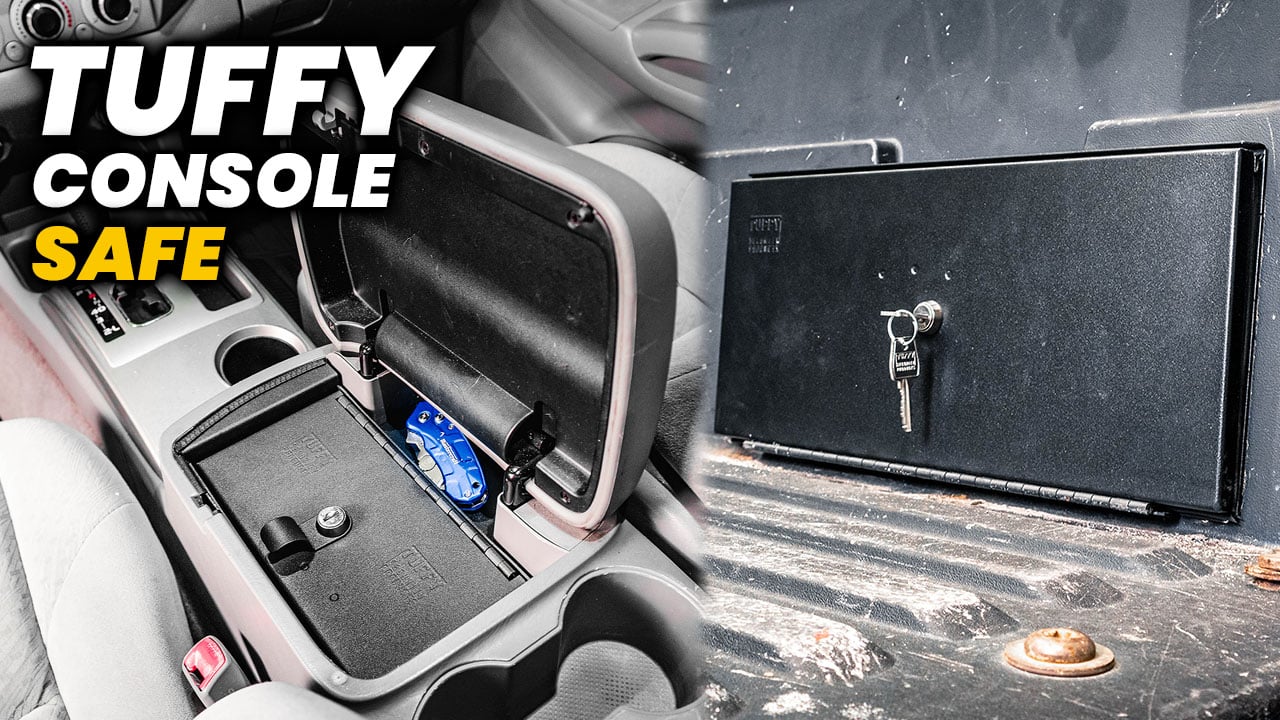You’ve only been at the dealership for a mere 5 hours, but the salesman finally handed over the keys and it’s time for that first drive in the new car. Obviously, you’re a smart consumer and you told the finance guy where to stick his “True Coat,” but beat them up enough to have them throw in the floor mats for free.
The car may look new however it’s not perfect and it’s not prepared for the real world yet.
Car enthusiasts take pride in maintaining that “like new” appearance and I believe the first step should be considering the conditions your vehicle will be subjected to. Do you live in an area with harsh winters where they salt or spray the roads?
If that’s the case, rust is obviously going to be your toughest enemy. Perhaps you live in a milder region where the sun bakes the clear coat off and cracks the dashboard. Worse yet, maybe your car will be subjected to the only thing that can wreak more havoc than anything Mother Nature could dream of- KIDS.
Ok, obviously you spent a lot of money on this new car, and want to keep it looking good, but you need to be realistic about what level of perfection can be maintained. Let’s not bother with ceramic coating the calipers on your Toyota Sienna. Maybe skip the rust protection on the Miata that will only see perfect weather in the summer.
If you want to go crazy with prepping and protecting every surface of your new car, here’s a checklist to give you some ideas:


Many of the things on this checklist are pretty self explanatory. Let’s dive deeper into some of the different areas and use cases to think about.
Interior Protection
For starters, it’s worth noting that modern car interior materials already have UV protection built into them. So the purpose of using some of the recommended detailing products is to make the surfaces easier to clean in the future as well as protect against things like dye transfer from your jeans.
Personally, I find keeping the interior of a car clean to be incredibly rewarding and help maintain the resale value. We can’t all have garage queens, so as much as I love seeing the shine on a clean car, it can be frustrating when I need to drive it in the rain! At least when I have the interior clean, I can enjoy it that way a bit longer.
The first thing I buy for any car is a quality set of floor liners- not floor mats. The difference here being that a floor liner rolls up the sides of the footwell area, making it harder for the dirt and salt you track in to find a way behind it.
WeatherTech is the go-to brand for these, but OEMs have started making really nice ones lately too. It seemed like for the longest time they only offered carpet or rubber mats.

The ones in my Tacoma are excellent and I’d take them over WeatherTech. They go high enough up the sides, but are a softer rubber material whereas WeatherTech is a stiffer plastic. I like the rear seat liners that are one piece for even more coverage. Most factory second row mats are smaller than a child’s pair of shoes and offer zero protection for the middle seat area.
Another area where you may want to add a layer of defense is the backseat if you have small children. If your child has a tendency to kick the seat backs, there are many products available to hang over the seat to prevent scuffing. A lot of parents add protectors under child seats as the sharp edges can dig in over time and leave permanent indentations.
Be warned though- these seat protectors are not forced to follow the same stringent testing procedures that child seats are and may compromise the safety. If you opt to buy one of these, check with the manufacturer of the child seat to see if they offer a product designed for use with their seat.
Next up, an easy way to protect the interior is to have your windows tinted. Yes, dark tint is illegal almost everywhere, but you don’t need blacked-out windows to keep out the damaging sun. The sun can cause the plastics and leather to crack and discolor.
I usually do around 35% tint which is a little beyond legal limits where I live, although not extremely dark. If I happen to be pulled over, I immediately roll all the windows down. Fingers crossed, but I haven’t gotten in trouble for it yet. Proceed at your own risk!

While we’re on the topic of interior plastics, throw out that old bottle of Armor-All. There are much better products available that can protect your interior without making it look like an oil spill occurred.
Leather seats will need to be cleaned/conditioned regularly to keep them soft and prevent that greasy sheen that happens with use. Lexol makes my favorite products for this, and I think their conditioner smells amazing which is a bonus.
Leather is a durable material and easy to keep clean, but if you have cloth seats, don’t think you have to spend hundreds on mystery protection the finance guy was pushing on you. I’ve been using BlackFire Fabric Protectant which can be sprayed on seats and carpet to waterproof them and prevent stains. It’s only about $30 and you simply mist it onto a clean surface.
I try to make a habit of conditioning leather seats at least twice a year. Take note- unless you have something high-end and splurged for the full leather interior, then your peasant-mobile like mine probably only has leather “seating surfaces”. The sides, back, etc. will be vinyl and you’ll want to use the appropriate product for the type of material you’re treating.

Rust Prevention
This is by far the most difficult challenge a car enthusiast has. Around me, vehicles start rusting through or having the paint bubble after around only 10 years. While this is depressing, cars have definitely made progress- my dad tells tales of brand new cars being rusty on dealership lots in the 70s.
The traditional method of undercoating is a tar-based application. Most people do this as a one-and-done treatment. It works really well, until it doesn’t…. you see, over time, this coating can crack and allow moisture behind it. The water can become trapped in there, giving it more time to eat away at the metal. If this occurs, you would have been better off with nothing!
Another old-school technique is spraying oil on the underside of the car. This style will drip off for a while and can be a bit messy. You’ll need to redo it annually though since it’s not a permanent coating.
This method is effective if applied thoroughly and properly- if you’re paying someone to apply it, ask them if you can look while it’s on the lift to verify complete coverage. Check to see that they did inside all the doors, hatch/trunklid/tailgate, hood, etc.
Check out this article for an in-depth look at oil spraying:
My favorite type is the “dripless” spray such as Fluid-Film. This won’t make a mess of your driveway like a conventional oil spray and holds up much better too. There are shops around that will apply this for you, but you can purchase it yourself. It can be sprayed with a compressor out of a cheap gun but is available in aerosol cans as well.
You’ll still want to at least touch it up a bit every year, but it won’t be as much work as doing the initial application. Dust and dirt will stick to the coating as you drive, but the metal will still be protected. Again, the effectiveness of this spray is dependent on how well it is applied.
Paint Protection
Unfortunately, even buying a brand new car does not guarantee the paint will be in pristine shape when you take delivery. The car has already traveled quite aways with a combination of boats, trains, and trucks. Along the way, it has picked up contamination and will not be perfectly clean.
Even worse, there’s a chance the dealership already installed swirl marks when they got their hands on it by washing it improperly. I always request they don’t wash it and in a few instances, I’ve been able to peel the protective plastic off myself.
When you bring it home, give it a good wash and decontaminate the paint. I like using TRIX Tar and Iron Remover from Carpro and then washing it a second time using a clay mitt. If the paint still isn’t as smooth as I’d like, then it’s time to break out the clay bar and go over the whole vehicle.
Even if you’re not obsessed with how smooth the paint is, wax and coatings go on and off with significantly less effort once you’ve clayed it.
Now is the best time to decide if you want to have a PPF (paint protection film installed) as this will help prevent stone chips and wear. The sooner you have this installed, the better. I’m not the biggest advocate of PPF for a couple of reasons.
For one, if the PPF isn’t installed properly, the edges can lift and collect dirt which takes away from the appearance, especially on light colors. PPF can become stained or yellow over time- it may need to be removed due to one reason or another and my gosh can it be a royal pain to remove it and the adhesive left behind.
I recently purchased a 6 year old Chevy SS that had PPF installed since new. The piece on the hood had several yellow/brown stains on it that looked terrible, and I couldn’t help but start peeling it off.
I spent hours struggling with the adhesive and eventually found out that the 3M General Purpose Adhesive Cleaner worked the best. It was still a nightmare though and I’m procrastinating peeling it off the bumper where the edges lifted in a couple of places.
Once you have the paint clean and smooth, the next decision will be deciding if you want to apply a wax or coating to protect the finish or opt for a longer-term solution like a ceramic coating. There’s no wrong answer here but starting that protection from the beginning will make maintaining those good looks easier in the future.
The Nooks and Crannies
Now this is the point where normal people would consider the job done and start driving the thing. I realize that as you use it, there are areas that take a beating from debris coming off the tires and it is impossible to keep all surfaces free from damage. That doesn’t mean I can’t keep most everything near spotless!
Let’s start with the wheels. Modern design trends have led to increased wheel diameters which make it easier to peek through the spokes and see the backside of the wheel. Whenever I purchase a new car, I like to pull the wheels off to give them a thorough cleaning then apply a sealant to the front AND back.
This makes them a lot easier to keep clean during regular washes and then when I’m pulling them to switch to winter wheels and tires, I’ll give them another cleaning before reinstalling.
Usually, just this once-a-year cleaning is enough to maintain their original appearance. If I have a product that is collecting dust because I’ve become fond of something new to use on the paint, I’ll usually set it aside to use on the wheels.
These Corvette wheels are far from new although they don’t show it:

If your new car is equipped with Brembos or similar high-performance brake calipers with a smooth powder coated finish, then it is your god-given duty to keep these clean! They’re probably already dirty just from the drive home from the dealership.
Fill a spray bottle with soapy water and use a detailing brush (or an old paint brush will do) to clean them first. The brake dust won’t be that much work to remove, and application of a coating or sealant will keep the labor to a minimum in the future.
If you’re using a spray bottle, take extra care not to contaminate the rotors with it. Consider spraying onto your applicator instead of directly onto the caliper.
Having clean calipers simply goes hand-in-hand with a clean set of wheels.

Door jambs and trunk/hatch openings are other areas that tend to be overlooked. I used to attempt to apply regular paste wax in these areas, but that can be incredibly difficult. Recently I have switched to using a spray wax for this application and then wiping with quick detailer regularly. Make sure you do the doors too, especially the bottoms as they are prone to damage and collecting dirt.
Cleaning these as part of your regular cleaning gives you the chance to verify that drains in the bottom don’t become clogged. Clogged drains can result in water entering the vehicle and accumulation of mud and wet leaves will rot the metal.
The areas around the trunk and hatch work as gutter systems to move water away from seals, making it a good idea to apply coatings here as well.
I follow up a wash by giving these areas a spritz of quick detailer as I’m drying:

A lot of people will never see under the hood of their own car except maybe to top off the windshield washer fluid. Us enthusiasts take pride in having a clean engine bay though and as always, it’s easier to maintain that appearance if you start off right.
For the easy to reach areas like large plastic engine and battery covers, airbox, etc. I recommend applying the same plastic protectants you use on the rest of the vehicle. Then your favorite wax/sealant/coating for the bottom of the hood, shock towers, and other painted areas. For all of those hard to reach places, try a “wax as you rinse” product.

The new car smell and excitement may fade after a bit, but the appearance doesn’t need to. Following these tips will help keep your pride in that new car alive for many years and preserve the resale value as well.

Tim is the creator of Canadian Gearhead. His experience with auto detailing and working for Toyota shows through all of the articles posted here. He runs the Canadian Gearhead site and YouTube channel full-time now and currently owns a 2007 4runner, 2006 Tacoma, and 1991 MR2. Read more about Tim:





Leave a Reply